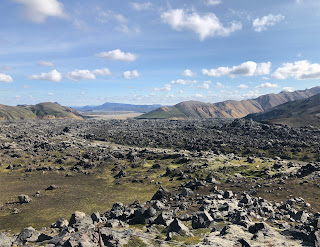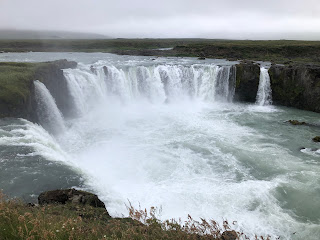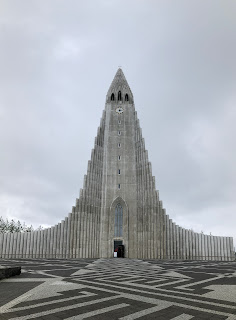South Iceland
Höfn is probably the point at which one reaches South Iceland.
We headed along the south coast, progressively working our way westwards, with
a couple of loops along the way. The coast is dominated by high cliffs in same
areas, and glaciers which approach the coast more closely than in the rest of
Iceland.
We visited Hoffelsjökull, Fláajökull, and Heinabergsjökull, all
of which were relatively quiet, unlike the popular Fjallsárlón lagoon, which we
visited the following day and which is clearly a major tourist stop. It’s easy
to see why since the lagoon is filled with floating ice from the glacier behind
it.



We stayed at the Fosshotel Glacier Lagoon, once again to have
good internet access for work obligations. As mentioned, we visited Fjallsárlón
the following day, then made our way to Múlagljúfur Canyon, a really beautiful
canyon with high waterfalls in the canyon walls. We were fortunate in terms of
weather on our ascent, however it started raining on our way back down, and on
arrival at the car we made hot soup which was most welcome in the cold rain.

Our next stop was Skaftafell, where we walked to Svartifoss;
then we headed for Vik Campground. Vik is a main centre for the south coast,
and the campground is huge. It’s close to the famous “Black Beach” (although
there are other black beaches on the coast, this is the one publicized most). The
following morning we walked down to the Black Beach, then to “KatlaTrack” to
take a “Glacier Tour” with Sigrunharpa Grietasdottir in a giant 4x4 Ford Club
Wagon. This took us up to the glacier edge, where we put on crampons to walk into
the icea and explore an ice cave, as well as enjoying the scenery.


From Vik we headed into the highlands again, via the less used
route into Landmannalaugur, crossing rivers many times on the way to the
popular campsite. The last river crossing, which is actually two crossings, is
quite deep and so we watched others cross before doing so ourselves. The camp
site is extensive, there is a hot spring a short walk away, and there were many
visitors, who had come to enjoy this amazing scenery and to walk from the campsite.
It’s possible to take multi-day walks through the mountains, however we did a
one day walk in beautiful weather, returning to camp for dinner.
From Landmannalaugur we headed out of the area by the more
frequented route, stopping at Hrauneyar, the unexpected waterfall at Háifoss, at
Gjáin – an enchanting dell with multiple waterfalls, at Stöng Viking long house,
at Hjálparfoss, and finally at Þjórsárdalur Camping Ground (Sandártunga).

The next day was a day of many waterfalls (Gullfoss,
Hlauptungufoss, Midfoss, Brúarfoss), the Geysir (Strokkur) site, with multiple
geysers, and we camped at Laugarvatn after a stop at Fontana hot springs.On the
following, misty, morning we stopped at Urriðafoss, Eldstó (Volcano) Art Café, Gluggafoss,
then Gljúfrabúi/Seljalandsfossm, and Nauthúsagil Waterfall where we walked the ravine
before continuing into Þórsmörk,
along a road following the river bed which ultimately provide to be too much
for the car, whose clearance meant that progress was too
slow to be practical, so we returned and headed for Kvernufoss and then the
impressive Skógafoss. We camped in the site immediately below the falls, with a
view of Skógafoss from the tent. The next day we visited Hvolsvöllur, Vínbúðin,
Þingborg Ullarverslun (wool centre), Gallery Flói & Wool Centre, and then
Kerið crater, walking around the crest of the crater before heading to Friðheimar,
which is a tomato farm, although this doesn't do justice to the place which has
a huge production of tomatos and a restaurant inside the greenhouses, with (not
surprisingly) tomato-based cuisine, and which is very popular on the “Golden
Circle” tourist route. In the afternoon we visited Selfoss, where we camped.




We were well aware of the Fagradalsfjall Volcano,
which had been in eruption since prior to our arrival in Iceland, and which was
still erupting. We learned in the morning that temporary parking had been
established close to the volcano, from which trails were allowing access to
viewpoints from which the eruption could be seen. So we chose to take advantage
of the opportunity, made for the volcano,
and climbed to the first main viewpoint, from which the amazing sight of lava bursting
from the volcano could be seen. It was also possible to walk to the lava front
(the lave now having cooled) to see fresh lava which had flowed down the
valley. The spectacle was amazing, and our time was very well spent taking the
opportunity to see the volcano “in action” on a beautiful sunny day, on our
last day with the car.

Alan & Marce, 2021 July/August






















































